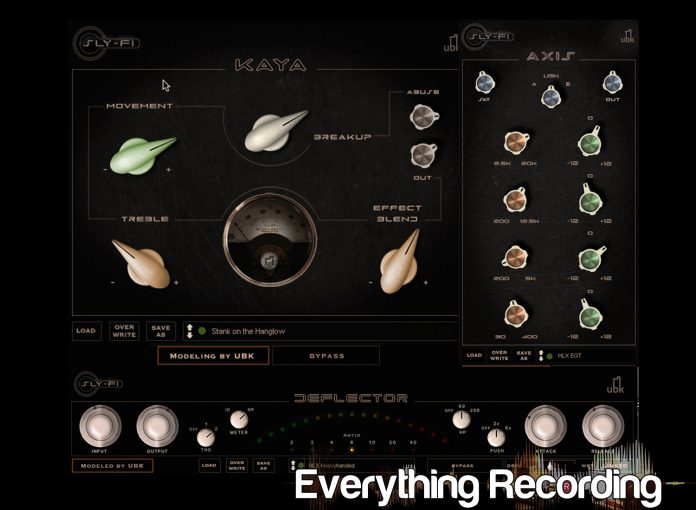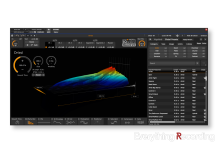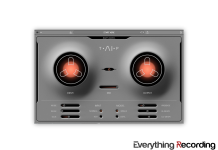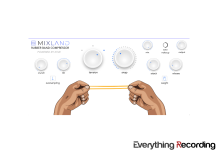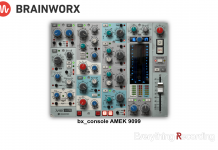With a name like that, how could you not buy it? The Sly-Fi Digital O.G Trifecta Bundle is a combination of three new plugins from a new company founded by Gregory Scott of Kush Audio infamy. Sly-Fi unveiled today to probably much surprise to most of the audio community but has been in the works for the last two years. Somehow UBK looked my direction and allowed me to get an early sneak peek of these new toys to see what I thought.
Sly-Fi is a slight departure for Gregory Scott, who up until this point has made plugin emulations of his own Kush Audio hardware as well as Pusher, an all out audio anarchy experience (REVIEW HERE). These processors were all original designs under the Kush name, but Gregory wanted to expand into different avenues of plugin design that did not necessarily fall into the Kush Audio family.
In the past, Gregory has steered clear of the emulation market probably due to the oversaturation of models to choose from. That is, until a close friend / Godsend to all of us suggested that emulation may be in the cards for him in a way that would be fulfilling. You see… being a pro audio gear mad scientist has its perks. For one, you can take gear that exists in the hardware realm and bend them to your exact will. Mr. Scott very much did that in his own studio with countless pieces of gear so why not make use of the DAW environment and code plugins that do the same thing? This creates the “unfaithfully modeled” versions of already genius pieces of gear and making them “geniuser”. Taking his knowledge of modeling his own hardware to plugins, as well as a new streamlined approach to software creation, Sly-Fi Digital was born.
Sly-Fi definitely kicks in the door of the digital world, bringing in three new plugins that serve three completely different but still similar purposes. You have the Deflector (compressor), Axis (EQ), and Kaya (distortion / coloration). At this point, you may be thinking, “doesn’t Kush audio already have three plugins that do pretty much the same thing? What could possibly be different that would justify buying three plugins similar to already existing ones?” Well, let’s find out together.
The interface definitely has the classic calling card of UBK’s vibe, with dark colors and shiny knobs that look like what people in the 60s thought technology of 2015 would look like (i.e.: if Will Robinson from Lost in Space had a recording studio). The plugins currently come in 32 and 64-bit incarnations of AU and VST, with AAX coming out early fall. Registration uses the iLok system, which should work just like the Kush plugins and allow for 2 licenses for 2 DIFFERENT iLoks. Generous right? Lets get down to the literal nitty gritty.
Deflector:
Deflector is a very symmetrically laid out compressor based on a common staple in just about every major recording studio. Embarrassingly, it took me a little bit to figure out which one it’s based on but once you start moving knobs around, it’s obvious. If you’re still having trouble figuring it out, don’t be too “distressed,” you’ll get it eventually. Operation on this compressor is very straightforward but powerful. Want more compression? Crank the input and click on the ratio you’d like. Attack and release work like you’d expect as well. Where it gets powerful is in the rest of the knobs. On the left, you are given a THD knob, which will inject distortion into the equation. THD1 seems to be a little more edgy and THD2 will take that same edge and add a little knock to the low end. The side-chaining is powerful as well. Your low end can be completely bypassed at either 60hz or at 250Hz, preserving all of that kick drum’s low end, while smashing that 2khz attack of the beater head. Speaking of 2khz, the “Push” knob will enhance the side-chain at either 2 or 6kHz to quell even the harshest of frequencies. I found myself using the 6kHz with aggressive compression to add pop to hihats and acoustic guitar. You get this really cool sounding attack with it on transient heavy material, almost like having a de-esser. Lastly, you can choose to blend your compressed in with your dry signal or just go all out dynamic havoc. I would’ve liked to see a THD blend knob to choose just how much distortion is placed on the source, but a simple dialing back of the input knob can attain a similar function.
This compressor is pretty versatile. Overall, it usually makes itself known when compressing material, but it isn’t just limited to dynamics paired with some dirty color. Dialed back with the THD off, you can get some surprisingly smooth subtle compression, similar to the 1176 or LA2A; but with a hard twist of the input, medium attack, paired with some push and THD, you’ve got yourself a distortion laden Valley People Dynamite. The only qualm I have with Deflector involves the input and output knob. When pushing the input to high levels, some sort of link switch to the output would be an incredibly useful feature. Having the two knobs compensating for each other would make dialing in the perfect amount of compression while riding the output volume so much faster. It could even be in the form of a slider under the input and output the make this interface perfectly symmetrical. That’s just the OCD in me talking though. Other than those small gripes, this evil cousin of UBK-1 is the creative engineer’s dream.
Axis:
Axis was named after the Jimmy Hendrix album that heavily obtained its sound from the original piece of gear this unit is loosely based upon. I have to say that Gregory Scott got it right on this iteration of the 312 series EQ. Axis features both the A and B versions that the curves have been adjusted to his dynamic taste. From using Axis, I suspect that the very top of the bell has an extremely sharp bump to add just a slight bit of pluck to the already punchy EQ’s bands. Where Axis gets it right is in a few key features. First, the vintage “A” version has 4 bands. We’ve all wanted that sorely. Secondly, there is UBK mode that takes the stepped knobs out of the equation. Sure sometimes having set frequencies and gain changes are useful and can create a good starting point, but freedom to choose is better. Where I’m torn in the 3 different modes is in how they behave between modes. Part of me loves that you can set use the 3 different modes as an A/B/C comparison, but the other part of me wants to be able to use one stepped mode and hold the EQ settings to bring into UBK mode for finer tuning. I know you can’t have it all, and executing this would even be tricky from a software standpoint so I understand. Maybe A/B/C mode button? I don’t know. Since Sly-Fi is enhancing the classics for the better, a cool low cut filter would’ve been cool as well. I can see how I’m looking like a diva here but these are simple operational additions not affecting the actual vibe and tone these plugins produce. Once again, just like with Deflector, the character that you get with Axis easily blows any other emulation of this EQ out of the water. I haven’t even mentioned the best feature of this EQ. Sly-Fi, could’ve made a single knob plugin out of the “Sat” knob on Axis and it would’ve been worth every penny. This is an actual tweak Gregory added to his hardware version of this EQ. The “Sat” knob adds a rich distortion into your signal that breathes new color into your track. This knob in itself feels like it has an EQ of its own built in that hits just the right corner frequencies. I’ve been told that the Sat knob has pre and post emphasis that alter the relationship of the high and low frequency content as you adjust the knob. So it’s not quite an EQ but a game changer nonetheless. In a lot of cases, I’ll just reach for it on its own before even starting any EQ. Drive it even harder and you get something special all its own.
Kaya:
So far we have a dynamics tool that adds distortion and an eq that adds distortion. Naturally the next tool is a distortion that also adds… you guessed it… even more distortion. Kaya is based on something none of us will ever most likely own or even see for that matter. One of Gregory’s close friends S. Husky Huskulds created this Frankenstein out of an old Ampex tube tape deck. This box was made for one purpose, filthy sweet, swampy, sexy, booming distortion, but Sly-Fi has made some very novel tweaks. Even just opening the plugin on a track adds a noticeable change in the low end. You will immediately hear an undertone of bloomy saturation in the background. Start turning the breakup knob and you will hear what I can only describe as the distortion equivalent of a smile EQ curve. The low-end overdrive rolls out a little more prominent and the top end crackles slightly. The movement knob will tempt you with its standout b-movie alien green color. I suspect there is some sort of quick release low frequency side-chain compression blended in to some extent. Either way it adds an undercurrent of twitchy low end. The treble works like a quasi-tilt EQ that can easily add or take away edge to the signal. This knob could almost be used on its own to de-harsh just about any content without clouding it up. The blend knob does just that and allows you to “wrangle your mangle” perfectly to taste. If all of that wasn’t enough, the Abuse knob works as the nitrous shot to the audio and adds just a little (or a lot more) dirt to the signal.
I’m just going to come out and say it. Screw journalistic integrity and the “don’t overhype or you’ll lose the audience” approach to reviews. I’m an independent news site and I can say whatever the hell I want. Kaya is a modern marvel of epic sonic proportions!!! It is by far the most fun I’ve ever had with a plugin. Usually you have two types of distortion boxes: the ones that are overly complicated and others that just give you harsh, grating, distortion that needs a lot of treatment after the fact; but Kaya gets it. It’s dubbed as a one trick pony but that’s painting what this plugin is capable with a broad brush. It very well may be the last distortion plugin you will ever need to buy. *Mic drop.
The inaugural crop of Sly-Fi creations brings a refreshing new perspective to both emulations and one-off ideas from the mind of a musical madman. The plugins still hold true to the UBK credo of “just turn knobs till it sounds good and forget the exact numbers” as well as adding tons of one-off character to tracks. Let’s get to the question you are all wondering. Are these just a repackaged UBK-1, Electra, and Pusher? The short answer is not in the slightest, but I understand your suspicion. These plugins are definitely cousins to the Kush Audio plugins but they’re those cool cousins you always want to see at holidays. Sly-Fi brings a whole new perspective to concepts you thought you had nailed down. Deflector alone is very obvious in its response to transient audio. I would suggest any newcomer to mixing use this plugin as a training tool of what compression actually does. You get a firm sense of control over your audio as well as options you never even really considered. Hiding saturation into every stage of the mixing process breathes new life into digital cold mixes. Even just cracking the “sat” knob adds a different dimension to all tracks and harkens to “how it used to be”. I have to admit, my eyebrow did raise a little two when seeing 3 new plugins that worked similarly to Kush Audio ones; but that notion very quickly disappeared once I started adding them to tracks.
Bottom line, if you still feel that these are in fact repackaged versions of Kush, grab a trial and try them out. When has anything UBK put out not steered you in the right direction? Now that Sly-Fi is Gregory Scott’s new playground for new digital toys, we need a delay and reverb plugin!
Price:
Deflector: $99.00
Axis: $99.00
Kaya: $79.00
For more information visit http://www.SlyFiDigital.com



